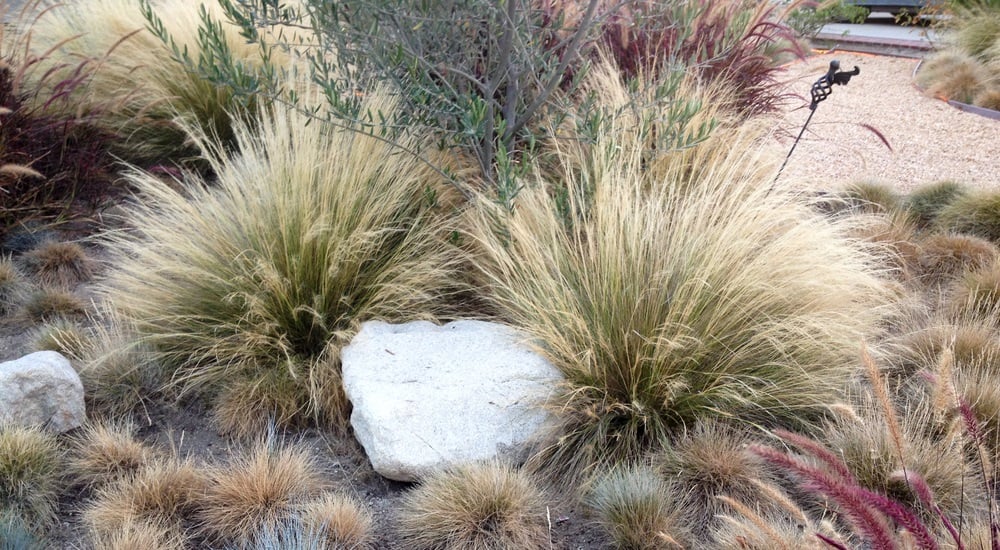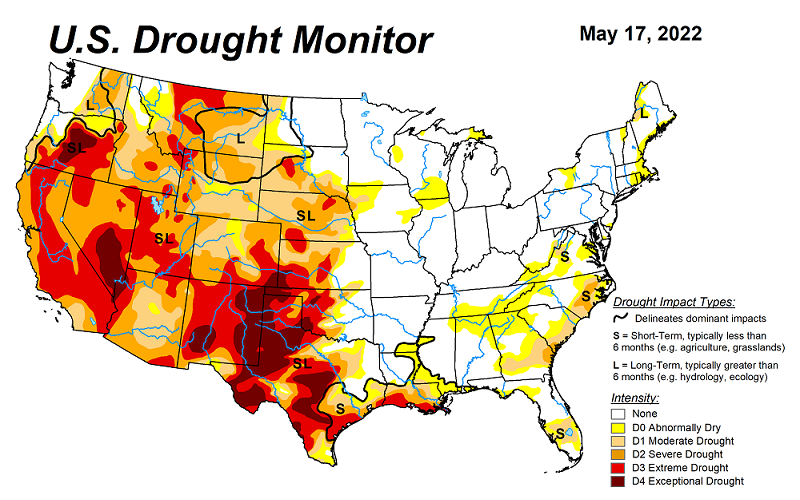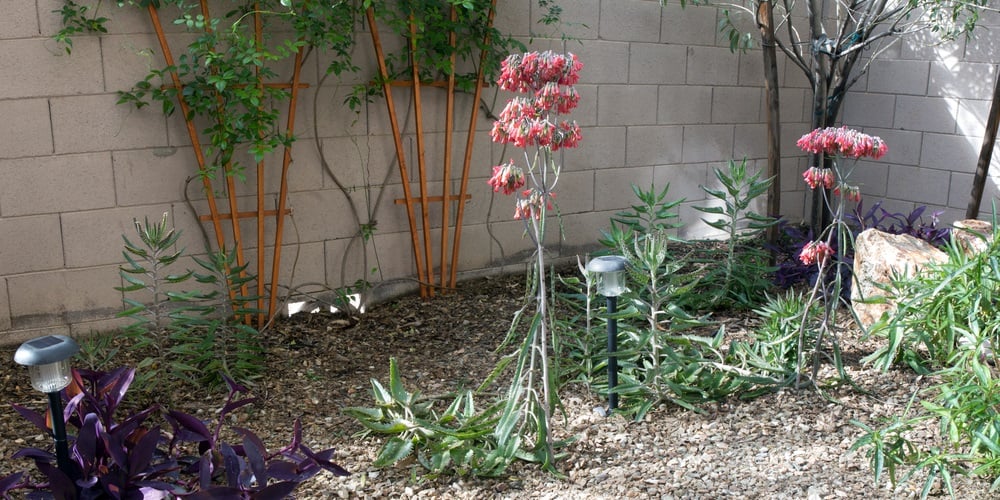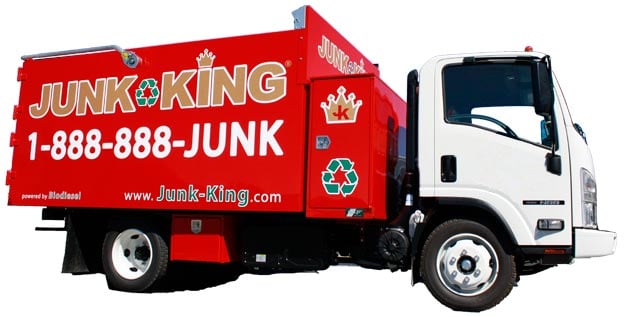
It's a meme in America: the suburban homeowner who prides himself on a lush, green, and meticulously kept lawn. But drought and heat wreak havoc on lawns.
Converting your lawn and other outdoor spaces to environmentally green and low-water use landscape designs will pay for itself over time with lower water bills. And less yard waste.
Less Grass, Less Water, Less Yard Waste - Going Green With Your Yard
The reality is that water conservation is a great thing for anyone, anywhere. However, another unfortunate reality is that in large portions of the United States today, drought conditions are still ravaging many states.
In fact, this particular drought has become so prolonged and severe that many reservoirs across the western half of the country are at record lows.
Several states are mandating water restrictions and in states like California, 95 percent of the state is in "Severe Drought" while more than half of that area is in a state of "Extreme Drought." But the states of Texas and New Mexico are suffering even more so.
Here is a recent map from the U.S. Drought Monitor (USDM) that gives a distressingly graphic representation of how vast the current drought conditions are:

(Map Courtesy of USGS)
However, despite the drought and more restrictive water usage, people still work and live in all these places. And this includes having lawns, having backyard get-togethers, and doing all the things that homeowners and others do in their yards.
But lawns comprised of nothing but lawn grass are problematic in light of the drought, not to mention the ever-increasing water rates in many areas.
So, what's the best alternative to having all that lawn grass that has to be watered, maintained, fertilized, weeded, raked... and on and on? One great option is to install a low-water or drought resistant landscape design.
When New Landscaping Means Hardscaping and Low-Water Plants
While it may be difficult to make the shift from the traditional lawn with it's (hopefully) lush and vivid green expanse of thick grass, there are some great benefits to a low-water design.
As the guys at The Ground Guys have noted, the biggest reason to plant a low-water landscape is to save money on watering costs. Other benefits include:
- Increased curb appeal, which can lead to higher home value
- Conservation of natural resources and decreased energy use
- Creation of habitat for native wildlife
- Reduced landscaping labor and maintenance costs
And your options for a more "green" and water conserving yard include a mix of a smaller area of lawn grass complemented by and surrounded with planter areas filled with various low-water and drought-tolerant plants, as well as hardscape elements like walkways, benches, planters, and large rocks.
On the extreme end of the low-water transition, you could even remove all your lawn grass and have only crushed gravel, landscape sand, and other stone and rock elements.
All of these areas can be filled with a choice selection of shrubs, grasses, and other types of plants that require very little water, minimal maintenance, and provide color and visual beauty to your outdoor spaces. Not to mention no more bagging grass clippings and raking!
So, what are some tips and best practices for creating a low-water yard?

Xeriscaping: Landscaping to Reduce the Need for Watering
Xeriscaping for residential (and commercial) properties is the practice of replacing grassy lawns with soil, rocks, mulch, and drought-tolerant native plant species.
This term might seem a bit "sci-fi" but it comes from the word comes from the scientific term for plants that are especially adapted to arid climates, called xerophytes.
For example, trees such as myrtles and flowers such as daffodils are drought-tolerant plants. And in arid desert areas like Arizona, xeriscaping allows gardeners to plant native xerophytes such as ocotillo. And, of course, all types of cacti and other succulents do well for xeriscaping, as well.
But don't think that you have to fill your yard with sand, rocks, and cactus just to have a proper low-water, drought-tolerant landscape!
As National Geographic points out,
"Cacti are far from the only plants appropriate for xeriscaping. Other drought-resistant plants include agave, juniper, and lavender. Many herbs and spices are used in xeriscaping, such as thyme, sage, and oregano. Some plants used for food are drought-resistant, such as black walnuts, Jerusalem artichokes, and sapodilla, a sweet fruit native to Mexico."
In addition to your plant selection, irrigation methods are a critical component of xeriscaping.
For example,
- Drips and soaker hoses direct water directly to the base of the plant and prevent water evaporation.
- More efficient irrigation occurs when types of plants with similar water needs are grouped together.
And a xeriscaped landscape needs less maintenance than an area landscaped with grass and water-intensive plants. So, less yard waste to removed and disposed of!
The folks at Eartheasy offer these additional tips for successful xeriscaping:
- For best results with drought-resistant plantings, use regionally-specific, native plants. Exotic species can be extremely invasive and can spread into natural ecosystems by birds and other wildlife.
- Windbreaks help keep the plants and soil from blowing dry. Use trees, hedges, shrubs or tall ornamental grasses as natural windbreaks.
- Avoid watering during the hottest, windiest time of day. Early morning is usually best.
- How much to water? Your plants should begin to wilt during the hottest part of the day, yet perk up as soon as it starts to cool.
- Minimize the number of young plants. New plants need water more often than mature plants, which have deeper root systems. They also require more pruning.
What about the costs?
While there will be an initial outlay of cash to transition, or xeriscape, your lawns, the savings in water fees, fertilizers, herbicides and pesticides, and other lawn maintenance costs will more than make up for the price of a xeriscaped outdoor space.
Plus, a good Xeriscape can increase property values which can more than offset the cost of installation.
Junk King: The Best Choice for Yard Waste Removal Services
Once you decide to get professional help with the yard waste removal and junk hauling part of your outdoor project, you need to decide which firm is the right one for the job. Of course, we can make that an easy decision for you since Junk King really is the firm of choice.
Junk King provides an efficient, safe and eco-friendly residential waste disposal and yard waste removal services so you don’t have to worry about the pickup or disposal of the debris after your project is complete.
And our professional debris removal team will break down and haul off any types of yard waste you have.
Whether you need our services several times during a landscape or yard waste cleanup project - or just once after you're done - our hauling experts will make sure that all your yard and building debris is out of your way so that you can get on with enjoying your new outdoor spaces!
At Junk King, our teams specialize in yard waste and landscape debris removal.
And our highly trained and insured yard waste removal team will show up at your home on time, as promised, and we'll call 15 to 30 minutes before we arrive. Once there, we’ll give you a free estimate based on how much room your junk and debris takes up in our truck.
All you need do is simply point and we'll haul the debris away - and with no hidden fees.
So, are you ready to get rid of your yard waste? It’s as simple as 1, 2, 3.
Make an appointment by booking online above or by calling 1.888.888.JUNK (5865).





